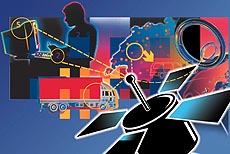Millennium bug’s first bite?
By Roopinder
Singh
YOU are cruising along the
highway, while your children explore the outdoors
trekking. Of course, you had the state-of-the-art
technology to help you navigate, when suddenly there is a
glitch. Your system is on the blink and you are lost.
Your children, meanwhile, also have a problem guessing
where on the earth they are.
 You plan a rally in the Himalayas
in which sophisticated navigational equipment would be
used for the first time in India. Just as everything is
falling into place, the logistics have been finalised;
you find out that the very system you were relying upon
to give your rallyists precise navigational assistance is
under a cloud. You plan a rally in the Himalayas
in which sophisticated navigational equipment would be
used for the first time in India. Just as everything is
falling into place, the logistics have been finalised;
you find out that the very system you were relying upon
to give your rallyists precise navigational assistance is
under a cloud.
A techno-nightmare? Not
quite. It became a reality last week. The effects,
however, were not quite the Armageddon-like as had been
feared. It was just a cyber hiccup that could have been
much worse.
One of the most common
navigational aids today is the increasingly popular
satellite receiver that tells you where you are. It is to
be found in most aircraft, ships, cars and even in the
backpacks of hikers.
Originally designed for
the US armed forces for guiding their missiles, the
Global Positioning System (GPS) has wider applications
now, just like the Internet. GPS is a satellite-based
system that transmits signals to receiving equipment. It
can be used to locate positions anywhere on the earth.
Operated by the U.S.
Department of Defence, GPS provides continuous (24 hours
a day), real-time, 3-dimensional positioning, navigation
and timing worldwide. Any person with a GPS receiver can
access the system, and it can be used for any application
that requires location coordinates.
The Russian Federation
has its Global Navigation Satellite System (GLONASS),
which has much in common with GPS in terms of the
satellite constellation, orbits, and signal structure.
Both systems are owned and operated by their respective
defence departments, and offer precise, global, and
continuous position-fixing capabilities. Both transmit
spread spectrum signals at two frequencies and have
pledged to make a partial set of signals available for
civil use without any user fees for the next 10 years, or
more.
The signals for civilian
use in both are intentionally degraded and are less
precise than those for use by the military.
GPS is available in two
basic forms: Standard Positioning Service (SPS) and
Precise Positioning Service (PPS). SPS provides a
horizontal position that is accurate to 100 m. PPS
horizontal accuracy is 20 m.
GPS has successfully
proven itself in classical navigation application, and in
fact, in popular usage has become the de facto
navigational system. Because the user does not
communicate to the satellite, GPS serves an unlimited
number of users.
The US Air Force
launched the first GPS satellite in early 1978. There are
now 24 satellites orbiting the earth at an altitude of
about 10,900 miles. The high altitude ensures that the
satellite orbits are stable, precise and predictable, and
that the satellites’ motion through space is not
affected by atmospheric drag. These 24 satellites make up
a full GPS constellation.
On board each GPS
satellite are four atomic clocks, only one of which is in
use at a time. These highly accurate atomic clocks enable
GPS to provide the most accurate timing system that
exists. It enables distances to be calculated from the
time signals take to travel across the network. The
system is designed to maintain full operational
capability even if two of the 24 satellites fail.
Why would something so
reliable have a bug? The answer is simple. It had
experienced a Y2K-like glitch Saturday last. The problem,
known as the "end-of-week rollover," comes from
the way the satellites keep track of time.
They determine time by
counting the weeks since January 5, 1980. They count the
number of weeks up to a maximum of 1,024 weeks (19 years,
eight months). They then return to week zero and start
all over. This is broadly similar to the kind of problems
associated with the millennium bug or the Y2K problems as
it is commonly called.
Though most of the
sophisticated receivers manufactured in the past five
years were equipped to handle the problem, some receivers
did malfunction because they took the date when the
satellite clock was reset as January 6, 1980.
Widespread disruption,
which was feared would occur when this happened, did not
take place, though emergency services were on an alert.
A Japanese company that
manufactures car navigators, however, reported that it
had received about 600 complaints from drivers who said
that their route went blank or flashed up gibberish.
The sets were fixed soon
thereafter and things were back to normal. Once the GPS
systems have gone past the rollover period, no other
problem is foreseen. So there is nothing for the
rallyists to get worried on this score.
One of the reasons for
the less-than-expected damage was the widespread
information about possible glitches, as well as the fact
that most of the sophisticated systems do not use only
GPS for their navigational needs.
Thus while driving your
car, all you had to do was also to be aware of your
actual surroundings using the empirical data brought to
you through devices that have been with you since you
were born — your eyes and your ears. The marvellous
analytical bio-electrical instrument — the brain,
would process it. All your children had to do was to also
keep a look out for real landmarks rather than virtual
contours marked in their GPS systems. Nothing like the
real thing!
|

![]()

